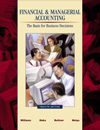 |
1 |  | 
Which of the following is not an example of a current liability as of Dec. 31, 1999? |
|  | A) | Management fees collected in advance in 1999, to be earned during 2000. |
|  | B) | The portion of long-term debt due in 2000. |
|  | C) | Warranty liability for products carrying a two-year warranty and sold during 1999. |
|  | D) | The interest due to creditors and bond holders for 2000, to be paid in 2000. |
 |
 |
2 |  | 
At the end of 1999, Braddock Company failed to make an adjusting entry to record the interest accrued on a note payable. As a result: |
|  | A) | Braddock's current ratio is understated. |
|  | B) | Braddock's working capital is overstated. |
|  | C) | Braddock's current assets are overstated. |
|  | D) | Braddock's owner's equity is understated. |
 |
 |
3 |  | 
Employers do not make deductions from employees' paychecks for: |
|  | A) | Federal income taxes. |
|  | B) | Employee's share of health insurance premiums. |
|  | C) | Federal unemployment taxes. |
|  | D) | Social security taxes. |
 |
 |
4 |  | 
Which of the following does not correctly describe a characteristic common to both capital stock and bonds payable? |
|  | A) | Issuance requires formal approval by the SEC if sold to the public. |
|  | B) | Both may be traded on the organized securities exchange . |
|  | C) | The market price fluctuates daily. |
|  | D) | The issuing corporation is obligated to pay periodic cash payments to investors who have purchased either capital stock or bonds. |
 |
 |
5 |  | 
Suppose that as a result of a change in credit policy, the Federal Reserve reduces market interest rates. How will the market prices of outstanding bonds payable be affected by this reduction in market interest rates? |
|  | A) | Existing bond prices will fall. |
|  | B) | Existing bond prices will increase. |
|  | C) | The impact on existing bond prices will be unpredictable. |
|  | D) | Although the prices of new bonds issued will fall, existing bond prices will be unaffected. |
 |
 |
6 |  | 
Based upon the concept of present value, a bond that paid a "below market" rate of interest (say 3%), would sell at: |
|  | A) | A price above its maturity value. |
|  | B) | A price equal to its maturity value. |
|  | C) | A price below its maturity value. |
|  | D) | None of the above. The bond might sell above or below its maturity value, depending upon the creditworthiness of the issuer. |
 |
 |
7 |  | 
A company's quick ratio: |
|  | A) | Can never be larger than its current ratio at the same date. |
|  | B) | Indicates the length of time the company takes to pay its short-term creditors. |
|  | C) | Indicates how quickly the company converts its current assets to cash. |
|  | D) | Is computed by dividing current assets by current liabilities, excluding accounts payable for inventory purchases. |
 |



 2002 McGraw-Hill Higher Education
2002 McGraw-Hill Higher Education